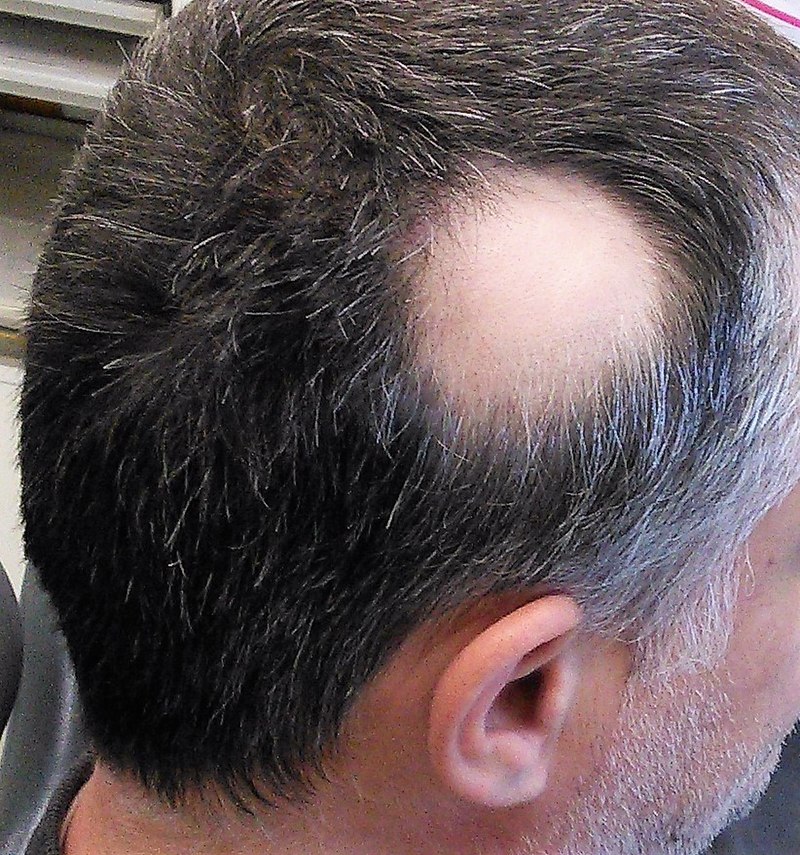Playlist
Show Playlist
Hide Playlist
Androgenetic Alopecia: Pathophysiology
-
Reference List Pathology.pdf
-
Slides Androgenetic Alopecia Pathophysiology Dermatopathology.pdf
-
Download Lecture Overview
00:01 Welcome. This is a very important topic, especially for the men in the audience, but I will say that 10 to 20% of the women will also have the same concerns. 00:11 So this is androgenic alopecia or hair loss related to hormonal stimulation. 00:17 So androgenic alopecia is really due to the androgen dihydrotestosterone. 00:23 This is one of the metabolites of testosterone period. 00:27 The epidemiology clearly happens more commonly in men because they have higher levels of testosterone, and therefore make more of the five hydroxy testosterone. The prevalence does increase with age. 00:39 That's because the follicles that are responding to the metabolite of testosterone are bombarded with progressively longer and longer and longer amounts of of that hormone, and therefore tend to have more hair loss with time will effect. 00:56 Sadly, 80% of men by the age of 80. 01:00 So we should all live so long. 01:02 But at that point there will be some degree of hair loss. 01:06 There is a lower prevalence in non-European populations. 01:09 This actually has to do with levels of expression of the receptor, and not so much by levels of of expression of the testosterone. 01:18 And as I've already mentioned, 10 to 20% of women may also be affected by this same general pathophysiology. 01:25 So what is going on here? There is a genetic predisposition. 01:29 This is clearly an androgen dependent trait. 01:33 It is the sensitivity or the kind of the the predisposition is transmitted by the X chromosome. So it's not from your dad. 01:41 Guys if your dad's bald don't worry about it too much. 01:44 If your mom's dad was bald, do worry. 01:47 It's related to the X chromosome because that's where the androgen receptor is coded. 01:52 So think about this. It's all about the androgen receptor. 01:56 So to understand how hair loss occurs we have to understand how hair growth normally occurs. And there are four basic phases of hair growth. 02:05 It's not just it's constantly growing. 02:07 In fact, it's growing, stopping, pausing and then restarting over and over and over again over the lifespan of an individual. 02:15 In the initial phase, called antigen, which is the growing phase, the hair shaft, the follicle at the base of the hair is actively synthesizing new keratin and making hair. In approximately 90% of all hair follicles are going to be in this phase, and they will be constantly synthesizing hair for over a period of time of 2 to 6 years. 02:35 At that time point, then they go into kind of a pause phase, a regression phase called catagen. 02:42 It's transitory, hopefully, where the follicle that's responsible for synthesizing the hair degenerates or regresses even. 02:51 And but fortunately it's brief. 02:53 Again, it's transitory. 02:55 Except if you have too great an exposure to the dihydrotestosterone. 02:59 And at any given time, in a typical individual who's not losing their hair, but a typical individual such as myself Of or are you listening? About 1% of all your hair follicles are in the catagen phase. 03:11 Okay. Short, transitory, a degenerative phase. 03:16 Then you enter into the telogen, or resting phase. 03:19 This is where the hair follicle is not actively synthesizing hair. 03:23 The keratin to make the hair, but is will be potentially able to be kickstarted and restart synthesis again in the antigen phase. 03:32 Approximately 10% of all your hair follicles are in the telogen phase, and this will last for 2 to 3 months. 03:38 So there's not an active regression anymore, but it's basically a pause in in the game plan. So you're not synthesizing the keratin or hair at this point. 03:47 And then when the hair is no longer being synthesized during this resting phase, it reaches a kind of terminal position. 03:57 The epithelium around the hair root kind of compresses the hair and you actually lose it. 04:06 So the terminal position in position in the follicle is reached and it detaches and that resting hair will come out. 04:14 So when you comb your hair, even now in your youth, as you're watching this, you will have a certain percentage of the hairs coming out on the comb. 04:23 Don't worry about it. That's completely normal at this point. 04:27 After the oxygen phase, then we can restart and we can go back into the antigen phase. If all is well with the hair follicle, if it is not, if it has not been destroyed, or if it's not being constantly maintained in catagen, that's the next part. 04:44 So this is normal in androgenic alopecia is when we change that ratio of antigen to catagen. Remember, most hair follicles 90% are going to be an antigen in most of us if we're maintaining our hair. 04:58 And the catagen phase, that regressive phase is only like 1% of the hair follicles. If we shift that ratio now, we're at risk of having significant hair loss. Us. Here's what's happening. 05:13 So the receptor, the dihydrotestosterone receptor, the DHT receptor on the hair follicle is going to be exquisitely responsible for driving hair synthesis from that antigen into the catagen phase. 05:29 It's going to be driving that that degenerative regressive phase. 05:34 So DHT binds to its receptor. 05:36 If you have more receptor or more DHT, you're going to have more hair follicles that are going to be influenced by that. 05:44 That shortened the antigen phase from 2 to 6 years to very short. 05:48 And you have a greater percentage of cells that are in the catagen phase. 05:53 And with that regression, you can actually have the hair follicle become shorter and shorter, less robust. 05:58 And even on successive cycles it's not making hair very well. 06:02 And then you end up with these short, fine, hyperpigmented so-called Velux hairs. 06:08 Vellus hair.
About the Lecture
The lecture Androgenetic Alopecia: Pathophysiology by Richard Mitchell, MD, PhD is from the course Degenerative Changes of Skin and Hair.
Included Quiz Questions
What percentage of hair follicles are typically in the anagen phase during normal hair growth?
- 50%
- 70%
- 90%
- 30%
- 10%
How does dihydrotestosterone (DHT) alter the hair growth cycle in androgenic alopecia?
- It prolongs the anagen phase
- It shortens anagen phase and increases time in catagen phase
- It eliminates the telogen phase
- It prevents hair follicle formation
- It blocks melanin production
Why is maternal family history more relevant for predicting male pattern baldness?
- The trait is Y-linked
- The androgen receptor gene is located on the X chromosome
- The trait is autosomal dominant
- The trait is mitochondrial
- The trait is autosomal recessive
Customer reviews
5,0 of 5 stars
| 5 Stars |
|
5 |
| 4 Stars |
|
0 |
| 3 Stars |
|
0 |
| 2 Stars |
|
0 |
| 1 Star |
|
0 |




